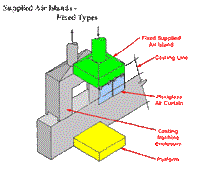Lead: Secondary Lead Smelter eTool
Engineering Controls » Supplied Air Islands
There are two types of clean air systems that can be used for secondary lead smelting operations:
Both systems:
- Protect the worker from exposure to contaminated background air.
- Help propel dust produced at the workstation away from the operator's breathing zone.
Supplied-air islands provide a zone of clean air at a workstation. The supplied air may come from outside the plant or the air may be filtered plant air.
Supplied-air islands are especially useful in limiting lead exposure when:
- An employee remains in a stationary position at the workstation for long periods of time. The SAI provides an envelope of clean air to a worker. The clean air flows down over the worker which normally keeps factory air from entering the clean air core.
- A supply of fresh, clean air is available. Note: Outside air may not require cleaning and costs will be lower. If no outside source of clean air is available, intake air should be filtered).
- The air is tempered. Employees will not remain in an environment that is too hot or too cold. Note: If the air is not tempered employees will block off the air flow with cardboard or other material in the winter or try to increase the flow for cooling in the summer which could result in higher exposures.
Design Specifications

The supplied-air island (SAI) should be designed to provide a laminar flow of fresh air through the employee's breathing zone at a low enough velocity so that additional airborne lead dust is not generated through reentrainment. The SAI height is typically 80 inches from the floor but is often restricted by overhead clearance limits and other equipment installed in the area. The air flow is designed so that the velocity measured at the employee's breathing zone is 100-150 feet per minute. Higher velocity may stir up lead dust. SAIs can be used in conjunction with exhaust- ventilated work benches. In this case, the air should be balanced so that make-up air is provided equal to the amount of the exhaust air.
Using clean air rooms can effectively lower lead exposure. Some clean air rooms are used as lead-free environments where employees can remove their respirators. These rooms need to have positive pressure, be tempered, and have a filtered air system with a HEPA filter designed to remove 99.97 percent of lead dust greater than 0.3 micron in diameter. An ante room should be included to give employees a place to remove their protective equipment without spreading contamination in the clean air rooms.
Perform the following to ensure clean air rooms are free of lead contaminants:
- Vacuum enclosures and scrub with soap and water so lead dust does not collect on flat surfaces.
- Ensure the structural integrity of all enclosures is intact and under positive pressure at all times.
- Develop a preventive maintenance checklist that includes schedules for:
- Replacing ventilation system filters
- Replacing ventilation system hoses, clamps, and blower internal parts
- Replacing window and door moldings
- Checking and replacing air shower ventilation systems, including automatic doors, blower, nozzles, and lighting.
- Monitoring intake and exhaust airflow to ensure that the rooms are under positive pressure at all times.


